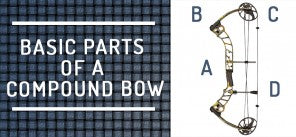
Bows and arrows have evolved quite a bit since their inception, but the parts on the compound bow have remained relatively unchanged in the past few years. There is a reason that the majority of bow hunters use compound bows. The edge that you can gain through the mechanical advantage that this bow offers is unmatched. Once you have been shooting your bow for some time, you will gain intimate knowledge of all the compound bow parts. If you are just starting, however, you are going to need a intro to the parts on your
compound bow.
A. You hold the riser on your hunting bow
The riser on your bow is the portion that you hold on to. It is where you will grip the bow. This is the piece that attaches to the limbs. If the riser is on the longer side, then the limbs will be shorter. This means that the bow will be comparatively harder to draw. Many compound bow risers will have standard pre-fabricated holes for your bow accessories. The riser is where you would install the bow sight, arrow rest, bow sling, cable guard, quiver, and stabilizer. If you choose not to use an arrow rest, you can shoot off of the arrow shelf on the riser.
B. The limbs propel the arrows
The limbs are the portion of the bow that attache to the riser via limb bolts. These bolts may or may not be adjustable. Check with your manual or manufacturer to see if you can adjust the bolts. Your compound bow should come fully set up, but you should be aware that there is a top limb, and a bottom limb. The styles will vary. There are split and solid compound bow limbs. They both offer their sets of advantages and disadvantages. There are also various types of materials that can be used to make the limbs, but compression molded fiberglass is the most common.
C. The compound bow cams give the bow power
The thing that makes compound bows so special, are the cams. There are many different variations that you could come across, depending on the bow that you choose. You can get a single cam, which will have one round idler wheel, and an oval (or elliptical) shaped cam on the bottom. Then there are the hybrid cams; these are two asymmetrical oval shaped cams. There are binary cams which are both elliptical; they sync the cams to each other, rather than the limbs. The last type that you are likely to see are twin cams, they can be either both round, or both elliptical.
You will either have a string, or a string and cables on you compound bow. The string/cables are what will be connected to your cams. The archery bow string is where you will place your peep sight, and D-loop if you are shooting with a release aid. You should attach the cable guard slide to the cable guard that is on the riser. Once this is done, you can clip the cable guard slide to the cables to ensure that they stay out of your way.
Everything on a compound bow is focused on the engineering behind it. Over the years, compound bows have become a preferred option for hunters because of this fact. There are many combinations that could get you the compound bow that you want. Study the differences in risers, limbs, cams and strings to see what the best compound bow for you would be. If you are just starting out in this sport, a thorough knowledge of all the parts is an absolute must before you attempt to hit the field. Bow hunting without the proper knowledge is a recipe for disaster.



Leave a comment